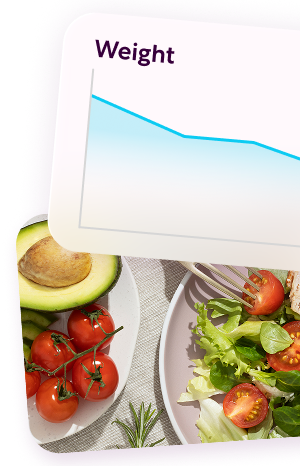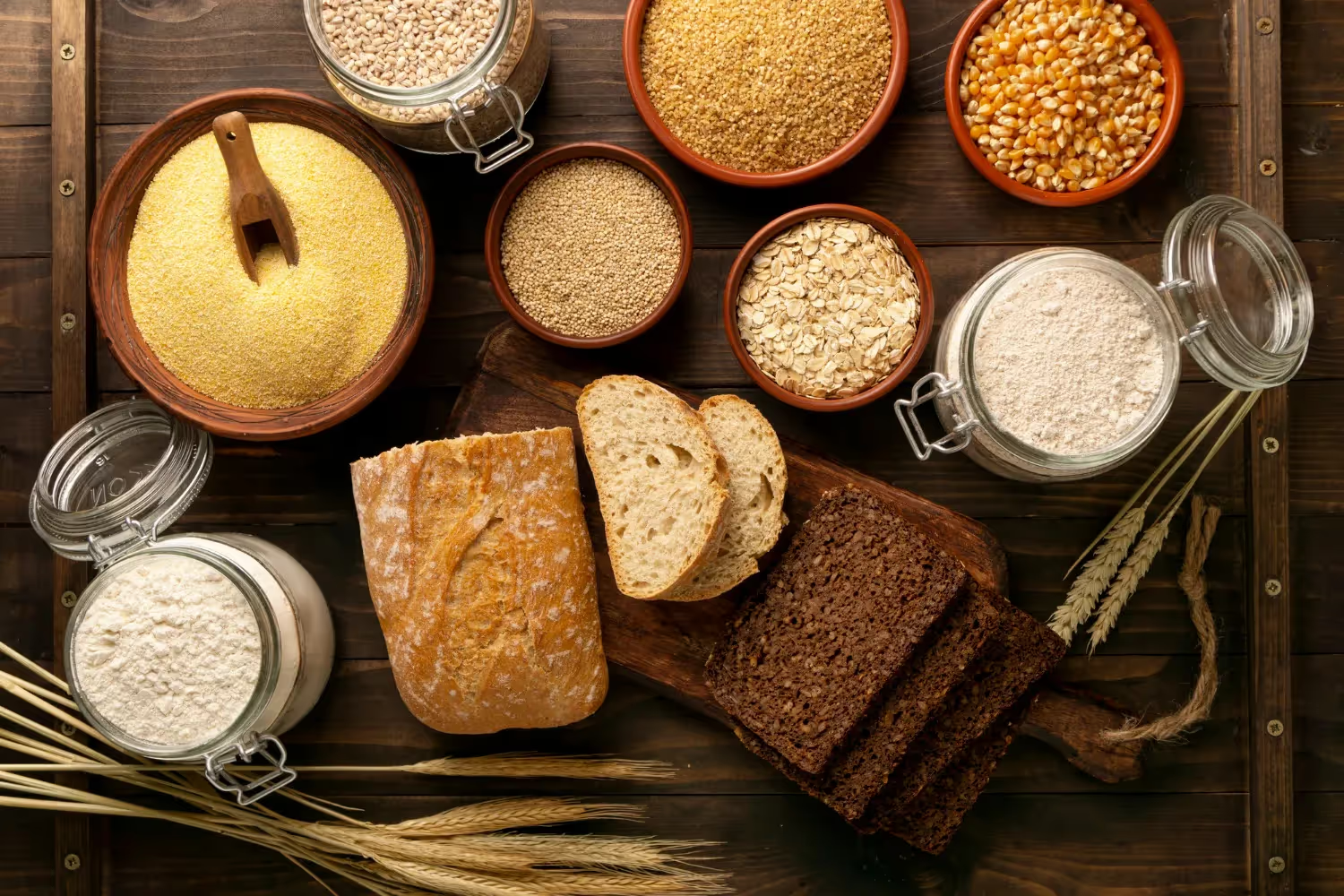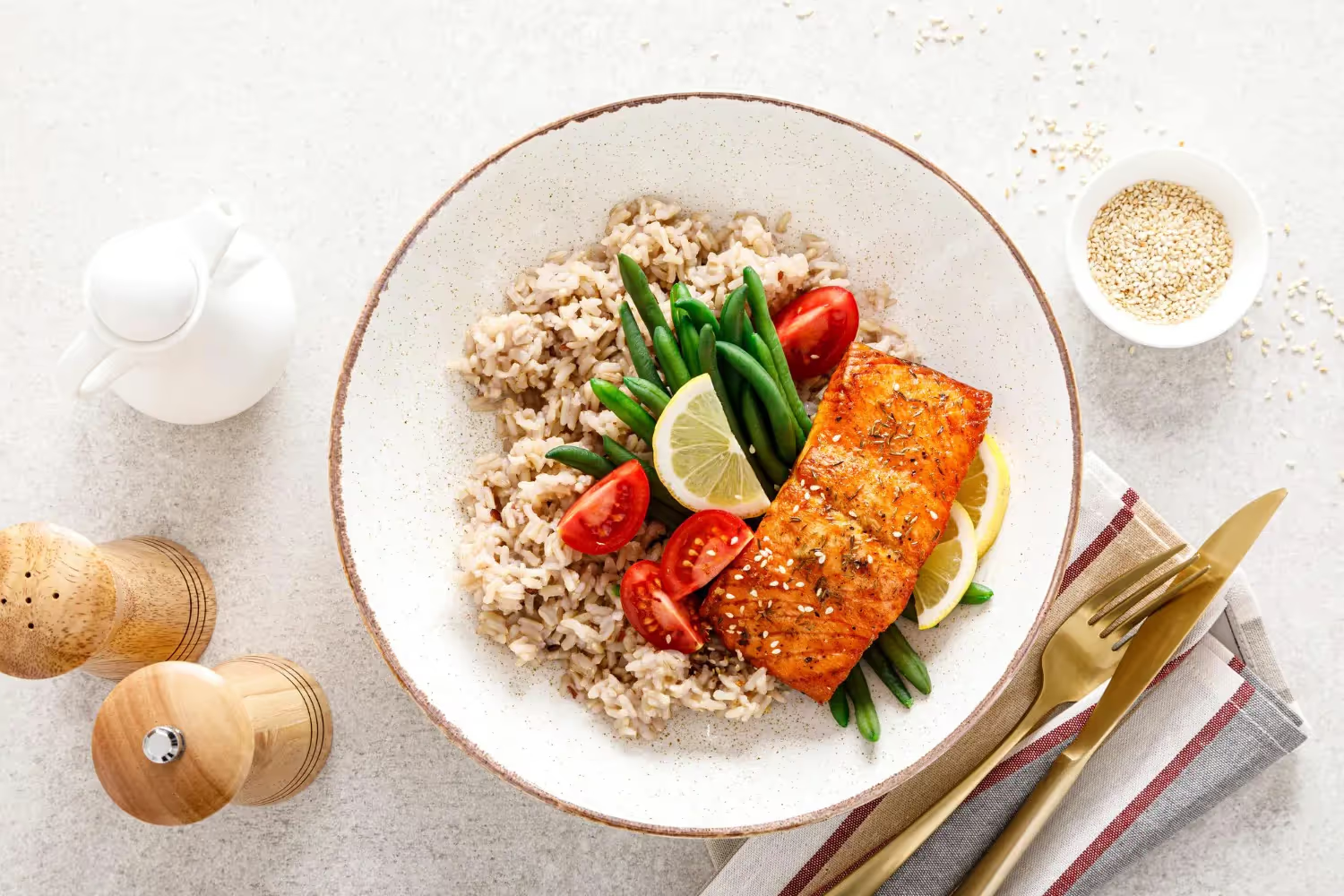Weight loss that fits your goals and your life.
Get your plan
Weight loss that fits your goals and your life.
Get your plan
Macros matter for hormone health, fat loss, and staying fit. It’s not a diet hack—it’s a way of life that can make going through perimenopause and menopause easier.
But doing macros for perimenopause weight loss can prove to be challenging if you’re new. We’re here to change this, this comprehensive guide provides practical meal planning tips and offers strategies to optimize your nutrition for effective weight loss.
Understanding Macronutrients During Perimenopause

As women approach or pass 40, reproductive hormones begin to fluctuate and steadily decline, leading to leading to symptoms that alter quality of life.
Understanding your perimenopause macros and the role of protein, carbs, and fat during can help balance hormones and alleviate symptoms.
Declining estrogen can lead to symptoms including hot flashes, night sweats, mood swings, impaired cognitive function, inflammation, increased appetite, weight gain, altered fat distribution, and a decrease in bone density and muscle mass.
Studies show that this weight shift also leads to an increase in the risk of chronic illnesses such as obesity, type 2 diabetes, osteoporosis, cardiovascular disease, and cancer.
Fortunately, nutrition plays a significant role in maintaining the body's systems, and has the power to reduce hunger, alter calorie intake, balance hormones, and alleviate perimenopause symptoms.
Below, we explore why macros matter and how to balance them to address the physiological changes during perimenopause.
What Are Macronutrients (Protein, Carbs, Fat) and Why They Matter in Perimenopause?
Research shows that macronutrients are important for your overall health. However, for women over monitoring protein, carbohydrate, and fat intake becomes even more important. Below, we discuss why each macro matters in perimenopause.
Protein
For example, protein helps to preserve muscle mass, preventing muscle loss. It is also the most filling macronutrient is shown to improve satiety and increase thermogenesis, which is when the body burns energy to digest, process, and absorb food.
Through this, hunger between meals is reduced, meaning fewer calories are consumed and increased energy expenditure. This can be used to form a calorie deficit for weight loss.
This is incredible for women experiencing perimenopause, as studies show weight loss can improve insulin resistance, lipid profiles, reduce inflammation, and oxidative stress, helping to address several factors which cause chronic illness and metabolic disorders.
Carbohydrates
Carbohydrates act as the body's primary fuel source. Studies show that complex carbohydrates contain three or more sugars, meaning they take longer to digest, resulting in a gradual increase in blood sugar. This improves blood glucose control and insulin metabolism.
Meanwhile, fiber, another carbohydrate, can improve gut health, defecation, while decreasing blood cholesterol and post-meal blood glucose levels.
Combined, these can address several perimenopause symptoms, helping to fuel the body, offer slow-release energy, and support gut and metabolic health.
Fats
Dietary fat is essential for our health. Research shows that fats are used a energy, provide cell structure, facilitate absorption of vitamins (A, D, E, and K), and hormone production.
Sources show that vitamin A is vital for bone health, immune development and function, and reproductive health.
Vitamin D is shown to promote calcium absorption for bone health, while being vital for bone growth and remodelling. It also influences cell growth, neuromuscular function, immune function, and glucose metabolism.
Vitamin E is an antioxidant that sources show protects against free radicals, which cause chronic diseases. Vitamin K is an antioxidant shown to protect against cellular damage, while containing anti-inflammatory properties, which work to fight off chronic illness.
Meanwhile, long-chain fatty acids EPA and DPA were associated with increased estrogen levels in non-menopausal women.
Fats such as omega-3 fatty acids can alleviate menopause symptoms. Sources indicate that omega-3 has anti-inflammatory and antioxidant properties, protecting against cardiovascular disease, lowering triglyceride levels. Further studies highlight its promotion of cognition, nervous system preservation, and protection against neurodegeneration.
These benefits highlight the major importance of healthy fats for women entering and experiencing perimenopause.
Why Macro Balance Becomes Harder — and More Important — in Perimenopause

A 2025 study revealed that the perimenopause duration lasts between 4–7 years, it the potential to last up to 14 years. As reproductive hormones fluctuate, balancing macronutrients becomes more difficult and important than ever.
Before perimenopause, tracking macros offers greater control over nutrition. However, during perimenopause, it becomes essential to address changes to fat distribution, declining muscle mass, and cognitive function.
Furthermore, poor nutrition can lead to deficiencies in calcium, vitamin D, and protein, which can impact bone health and muscle mass.
How Hormones and Metabolism Changes in Perimenopause Impact Your Macro Ratios
Studies indicate declining estrogen alters fat tissue distribution, which changes it from the gynoid shape (fat around the hips) to an android shape (fat around the abdomen), increasing the chances of obesity and chronic illness.
Combined with age and hormone-related muscle loss, alters body composition, increasing the importance of dietary protein. This is why many increase protein intake to 30%.
Alongside this, studies show that decreased estrogen increases the risk of chronic illnesses, including cardiovascular disease and cognitive decline.
Here, dietary fat is typically maintained at 30%, allowing for greater intake of omega-3 fatty acids. These provide an anti-inflammatory intervention, preserving cardiovascular health while supporting cognitive function.
A practical shift can also be made during times of lower activity, where you increase your protein intake, decrease carbs, while maintaining existing fat consumption.
Increasing protein will help improve fullness, thermogenesis, and stabilize blood sugar levels. Dropping carbs (especially refined carbs) can aid in weight management and improve insulin sensitivity. Here, a calorie deficit can also be used for weight loss.
Combined with eating a range of whole foods to ensure you are consuming your essential nutrients for greater overall health.
Best Macro Ratios for Perimenopause Weight Loss (Protein, Fat, Carbs)
A common starting ratio is 40% carbohydrates, 30% protein, and 30% fat, which is often used for weight loss and weight management.
Here at Reverse Health, we offer professional nutritionists and macro calculator for perimenopause to help you find the best macronutrient ratio based on your physical activity, age, and body type.
Below, we discuss macronutrient requirements and food sources to help you start regaining control of your health.
Protein Needs in Perimenopause (Prevent Muscle Loss and Boost Metabolism)

Protein intake is vital during perimenopause. Studies show that the decline of estrogen is associated with loss muscle mass, which can accelerate age-related muslce loss (sarcopenia). This can lead to loss of strength, function, and result in frailty, and loss independene.
Research shows that to maintain muscle, protein synthesis must equal protein breakdown, while increasing muscle mass requires protein synthesis to exceed muscle protein breakdown. This can be achieved through dietary protein intake and resistance training.
As mentioned, protein can increase thermogenesis, providing boost to metabolism.
How Much Protein Perimenopause Women Really Need
Studies suggest that the recommended dialy allowance for protein is 0.8 g/kg/day for healthy individuals, with requirements increasing to 1.4–1.6 g/kg/day for active individuals.
For individuals in a calorie deficit, the numbers increase further to 2.3–3.1 g/kg/day to help maintain lean body mass and support the body’s needs.
Research suggests adding approximately 25–30 g of high quality protein per meal. This will make it easier to hit daily targets, and increase fullness between meals.
Best Protein Sources (Animal + Plant Options)
Including a protein source in each meal and snack can help stabilize blood sugar levels and reduce cravings throughout the day. Below, we list the best protein sources for weight loss.
When selecting protein sources, you must be mindful of calorie content. Referring to the table, you will notice that while foods such as almonds, pumpkin seeds, chickpeas, chia seeds ,and walnuts are all excellent sources of protein, however, they are calorie-dense.
This does not mean you should not eat them, but rather that you should stick to recommended serving sizes, and while prioritizing lower-calorie sources to avoid blowing out your daily calorie allowance.
Healthy Fats for Hormonal Balance and Energy

Healthy fats are a vital component of hormone regulation. As mentioned, declining and fluctuating estrogen levels lead to perimenopause symptoms, which can impact quality of life.
Sources show that fats are vital for energy sources and are the precursor of steroid hormones, which can help balance and provide hormone support. Below, we explore the best healthy fat sources and how to balance omega-3 and omega-6 fatty acids for optimal health.
Best Healthy Fat Sources (for Hormone & Brain Health)
Fats are essential for hormone production and overall health, especially during perimenopause. The key is to focus on healthy fats that support your body's changing needs.
Like protein, several omega-3-rich food sources are calorie-dense. Stick to the recommended serving size and monitor intake to avoid exceeding your daily calorie allowance.
Omega-3 vs. Omega-6: Getting the Right Balance
Incorporating healthy fat sources into your meals is vital for our health. However, when there is no balance between omega-3 and omega-6, it can lead to health concerns.
A 2021 study explains that up until 100 years ago, the ratio of omega-6/3 was 4:1 or less. However, the typical Western diet now protein a 20:1 ratio in favour of omega-6. This leads to a pro-inflammatory, pro-allergic, and pro-thrombotic state.
The common mistake is that many of us consume larger amounts of omega-6 through healthy foods without knowing that a balance must be maintained.
Food sources such as walnuts, sunflower seeds, sesame seeds, pumpkin seeds, and almonds are rich in omega-6. These should be consumed alongside the omega-3-rich foods listed above, such as mackerel, sardines, salmon, and tuna, with the aim of 1:2-1:4 ratio.
Carbohydrates in Perimenopause: Energy Without the Sugar Spikes

Carbohydrates are essential for fueling the body and daily function. Following a meal, carbohydrates are broken down into glucose, which is then absorbed into the bloodstream, increasing blood sugar levels.
Simple carbohydrates such as white bread, white pasta, rice, sugary, sugary drinks contain one or two sugars, meaning they are easy to digest and cause a rapid rise in blood sugar and insulin secretion. Research indicates that high intake of refined carbs increases the risk of insulin resistance, independent of obesity, resulting in metabolic disorders.
Complex carbohydrates, on the other hand, have the opposite effect, fueling the body and providing a gradual increase in blood sugar. This is invaluable during perimenopause, offering sustainable energy and fewer sugar spikes, while maintaining insulin sensitivity.
Choosing Complex Carbs Over Simple Carbs
While low-carb diets have gained popularity for weight loss, carbohydrates remain an important source of energy and fiber for perimenopausal women. The key is to choose the right types of carbs and consume them in appropriate portions.
Focus on complex carbohydrates, which provide sustained energy and essential nutrients:
Why Fiber Becomes Critical for Perimenopausal Women
Fiber is not only crucial for digestive health, but also for satiety, blood sugar stability, and cholesterol management, which are invaluable during perimenopause and for weight management.
When fiber is consumed, it slows digestion, promoting feelings of fullness and regulating blood sugar.
Sources suggest that 21 grams of fiber per day is sufficient for women, which can be consumed through broccoli, apples, pears, whole grains, legumes, nuts, and seeds.
Prioritizing high-fiber carbohydrates can help support your weight loss goals while maintaining steady energy levels throughout the day.
Sample Perimenopause Meal Plans (Balanced Macros for Weight Loss)

These sample meals balance protein, healthy fats, and complex carbohydrates to support your weight loss goals.
Each meal aims to provide 30 grams of protein, fiber, and omega-3 to improve fullness, stabilize blood sugar, and hormone levels.
We also have a fully dedicated article to Perimenopause Meal Ideas if you want to expand more on meal prep for perimenopause.
Breakfast Ideas
Example: Greek Yogurt with Berries and Chia Seeds
This breakfast provides a good balance of protein from the Greek yogurt, healthy fats from the chia seeds, and complex carbohydrates from the berries and granola. The fiber from the berries and chia seeds will help keep you feeling full.
- Ingredients:
- Greek yogurt (plain, 1 cup): 245g (8.6 oz) - 130 calories
- Mixed berries (1/2 cup): 75g (2.6 oz) - 30 calories
- Chia seeds (1 tablespoon): 15g (0.5 oz) - 70 calories
- Low-sugar granola (1/4 cup): 30g (1 oz) - 120 calories
- Total Calories: 350 calories
Example: Avocado Toast with Whole Grain Bread
This meal offers a mix of complex carbs from the whole-grain bread, healthy fats from the avocado, and protein from the eggs. The addition of hemp seeds provides extra protein and omega-3 fatty acids.
- Ingredients:
- Whole grain bread (1 slice): 40g (1.4 oz) - 100 calories
- Mashed avocado (1/4 medium): 50g (1.8 oz) - 80 calories
- Poached eggs (2): 100g (3.5 oz) - 140 calories
- Cherry tomatoes (handful, 5-6): 80g (2.8 oz) - 15 calories
- Hemp seeds (sprinkle, 1 teaspoon): 5g (0.18 oz) - 30 calories
- Total Calories: 365 calories
Lunch Options
Example: Quinoa Salad with Mixed Veggies and Tofu
This salad provides a good balance of plant-based protein from the quinoa and tofu, complex carbs from the quinoa and vegetables, and healthy fats from the olive oil dressing.
- Ingredients:
- Cooked quinoa (1/2 cup): 90g (3.2 oz) - 110 calories
- Grilled tofu (3 oz): 85g (3 oz) - 90 calories
- Mixed vegetables (1 cup): 150g (5.3 oz) - 50 calories
- Olive oil and lemon dressing (1 tablespoon): 15ml (0.5 oz) - 120 calories
- Feta cheese (optional, 1 oz): 28g (1 oz) - 80 calories
- Total Calories: 450 calories (without feta: 370 calories)
Example: Grilled Chicken with Sweet Potato and Spinach
This meal offers lean protein from the chicken, complex carbs from the sweet potato, and additional nutrients from the spinach. The pumpkin seeds add healthy fats and a satisfying crunch.
- Ingredients:
- Grilled chicken breast (4 oz): 113g (4 oz) - 170 calories
- Roasted sweet potato (1/2 medium): 100g (3.5 oz) - 90 calories
- Sautéed spinach (2 cups): 180g (6.3 oz) - 40 calories
- Olive oil (for cooking, 1 tablespoon): 15ml (0.5 oz) - 120 calories
- Pumpkin seeds (sprinkle, 1 tablespoon): 10g (0.35 oz) - 60 calories
- Total Calories: 480 calories
Dinner Recipes
Example: Salmon with Brown Rice and Broccoli
This dinner combines omega-3-rich salmon with complex carbs from brown rice and fiber-rich broccoli. The lemon-dill sauce adds flavor without excess calories.
- Ingredients:
- Baked salmon (4 oz): 113g (4 oz) - 233 calories
- Cooked brown rice (1/2 cup): 90g (3.2 oz) - 108 calories
- Steamed broccoli (1 cup): 150g (5.3 oz) - 55 calories
- Lemon-dill sauce (1 tablespoon): 15ml (0.5 oz) - 15 calories
- Total Calories: 411 calories
Example: Lentil Stew with Kale and Whole Grain Bread
This plant-based dinner provides protein and fiber from the lentils, additional fiber and nutrients from the kale, and complex carbs from the whole-grain bread.
- Ingredients:
- Lentil stew (1 cup): 200g (7 oz) - 230 calories
- Sautéed kale (1 cup): 70g (2.5 oz) - 33 calories
- Whole grain bread (1 slice): 40g (1.4 oz) - 100 calories
- Olive oil (for the kale, 1 teaspoon): 5ml (0.17 oz) - 40 calories
- Total Calories: 403 calories
Snack Ideas
Example: Almonds and Apple Slices
This snack offers a good balance of complex carbs from the apple and healthy fats and protein from the almonds.
- Ingredients:
- Apple slices (1 medium apple): 182g (6.4 oz) - 95 calories
- Almonds (1 oz, about 23): 28g (1 oz) - 164 calories
- Total Calories: 259 calories
Example: Hummus with Carrot Sticks
Hummus provides protein and healthy fats, while carrots offer fiber and complex carbohydrates, making this a satisfying and nutritious snack.
- Ingredients:
- Hummus (1/4 cup): 60g (2.1 oz) - 120 calories
- Carrot sticks (1 cup): 128g (4.5 oz) - 52 calories
- Total Calories: 172 calories
How to Adjust Your Macros for Perimenopause Weight Loss and Energy

How to Calculate Your Ideal Macros
The United States Department of Agriculture (USDA) Dietary Guidelines recommends that the ideal macros for women ages 31 to 50 are the following:
- 45% to 65% calories from carbohydrates
- 20% to 35% calories from healthy fats
- 10% to 35% of calories from protein (preferably lean or plant-based).
As mentioned, these figure change to the following for weight loss and weight management:
- 40% calories from carbohydrates
- 30% calories from carbohydrates
- 30% calories from fats
The USDA recommends a 1,800-calorie daily diet for women in their perimenopausal years. Their daily meals should consist of at least 810 calories from carbohydrates, 630 calories from fat, and 360 calories from protein.
Of course, this all can vary depending on your age, height, weight, and level of physical activity.
Below is the formula to calculate your basal metabolic rate (daily calorie allowance), using an example of a 42-year-old woman who is 170 cm tall and weighs 75 kg.
BMR Formula
- BMR= 10 x weight (kg) + 6.25 x height (m) - 5 x age (years) - 161
Now we apply the information: 42-year-old, 75 kg, 170 cm tall.
- 10 x 75 + 6.25 x 170 - 5 x 42 - 161 =
- 750 + 1062.5 - 210 - 161 = 1441.5 kcal/day
Once you have determined your daily allowance, you can adjust your intake to gain muscle, maintain weight, or lose weight.
- Increase Muscle Mass/Physical Activity: Requires a calorie surplus, which means consuming more calories than your daily allowance. This means more carbohydrate to fuel training sessions and protein intake for building muscle and recovery. This can be applied to strength training, cardio, and yoga
- Maintain Weight: Calorie intake equals calorie allowance.
- Weight Loss: Calorie deficit, which means consuming fewer calories than your daily allowance. This means you will be burning fat while your body is performing daily functions.
However, if you want to bypass the fancy calculation, try the Reverse Health quiz. This will help you determine your calorie and macronutrient targets for your specific goals.
Adjusting Macros for Increased Weight Loss
A good rule of thumb when adjusting macros for perimenopausal weight loss is to add more carbohydrates or protein, depending on your activity of choice and how long you exercise every day.
Different exercises have a unique impact on your body. Below, we highlight different calorie and macronutrient requirements for strength training, cardio, and yoga.
Strength Training
During a calorie deficit, protein requirements increase to 30—35%. This allows you to hit a 1.4–1.6 g/kg/day requirement to maintain muscle mass during weight loss and improve satiety.
Meanwhile, carbohydrate intake decreases to 40% and fat intake lowers to 25% to compensate for increased protein requirements.
Cardio Training
Requires a balance of macronutrients while prioritizing carbohydrates to fuel training sessions. Research shows that carbohydrates are the preferred fuel source for skeletal muscle contractions during high and moderate-intensity exercise.
For cardio, the recommended 45-65% carbohydrates, 10-35% protein, and 20-35% fats. This ensures there is sufficient carbohydrate for performance and to restore muscle stores of energy (glycogen) after each session.
Yoga
Yoga is less taxing, which means sessions will not require as many carbohydrates for fuel. For more intense yoga sessions, calories can be increased; however, macronutrient ratios can remain at 40% carbohydrates, 30% protein, and 30% fat to support weight management.
Monitoring Progress and Making Tweaks
Setting realistic calorie goals and a macronutrient range tailored to your needs can help you lose weight and keep it off during perimenopause.
Log your food intake and stay within range of your macros by focusing on whole foods like fruits, vegetables, healthy fats, complex carbohydrates, and lean meat or plant-based protein sources.
Don’t be afraid to mix things up based on how you’re feeling. These minor tweaks can help you put together the ideal diet. In doing so, you’ll learn more about your body, how it responds to certain foods, and what helps you achieve your desired results.
Again, slow, sustainable, and long-term-focused changes are the best way to go about your macros for perimenopause weight loss. Sudden and dramatic shifts can be harmful, are harder to track, and cause you to return to where you started.
It may take weeks or even months for results to show. Focus on long-term consistency and avoid falling prey to diet hacks unless they’re proven to work.
Conclusion: Sustainable Perimenopause Weight Loss with the Right Macro Balance

Calorie control is essential for addressing weight during perimenopause. Meanwhile, the right balance of macronutrients allows you to adjust your calories to help you achieve specific goals.
- Protein to improve fullness, build and preserve muscle, and aid in recovery.
- Healthy fats for hormone support and to protect vital organs.
- Carbohydrates and fiber provide sustainable energy, support gut health, and improve glycemic control.
Finally, while macros work for many people, there are other diet plans and recipes you can try if you feel they aren’t for you.
Weight loss that fits your goals and your life.
Get your plan
Sources
- Xiang X, Palasuberniam P, Pare R. The Role of Estrogen across Multiple Disease Mechanisms. Curr Issues Mol Biol. 2024 Jul 29;46(8):8170-8196. doi: 10.3390/cimb46080483. PMID: 39194700; PMCID: PMC11352819. https://pmc.ncbi.nlm.nih.gov/articles/PMC11352819/
- Halton TL, Hu FB. The effects of high protein diets on thermogenesis, satiety and weight loss: a critical review. J Am Coll Nutr. 2004 Oct;23(5):373-85. doi: 10.1080/07315724.2004.10719381. PMID: 15466943. https://pubmed.ncbi.nlm.nih.gov/15466943/
- Bosch-Sierra, N., Grau-del Valle, C., Hermenejildo, J., Hermo-Argibay, A., Salazar, J.D., Garrido, M., Navajas-Porras, B., Sáez, G., Morillas, C. and Bañuls, C., 2024. The impact of weight loss on inflammation, oxidative stress, and mitochondrial function in subjects with obesity. Antioxidants, 13(7), p.870. https://doi.org/10.3390/antiox13070870. https://www.mdpi.com/2076-3921/13/7/870
- Holesh JE, Aslam S, Martin A. Physiology, Carbohydrates. 2023 May 12. In: StatPearls [Internet]. Treasure Island (FL): StatPearls Publishing; 2025 Jan–. PMID: 29083823. https://pubmed.ncbi.nlm.nih.gov/29083823/
- Meijaard E, Abrams JF, Slavin JL, Sheil D. Dietary Fats, Human Nutrition and the Environment: Balance and Sustainability. Front Nutr. 2022 Apr 25;9:878644. doi: 10.3389/fnut.2022.878644. PMID: 35548568; PMCID: PMC9083822. https://pmc.ncbi.nlm.nih.gov/articles/PMC9083822/
- National Institutes of Health, Office of Dietary Supplements (ODS), 2023. Vitamin A and Carotenoids: Fact Sheet for Health Professionals. [online] National Institutes of Health. https://ods.od.nih.gov/factsheets/VitaminA-HealthProfessional/
- National Institutes of Health, Office of Dietary Supplements (ODS), 2023. Vitamin D: Fact Sheet for Health Professionals. [online] National Institutes of Health. https://ods.od.nih.gov/factsheets/VitaminD-HealthProfessional/
- National Institutes of Health, Office of Dietary Supplements (ODS), 2023. Vitamin E: Fact Sheet for Health Professionals. [online] National Institutes of Health. https://ods.od.nih.gov/factsheets/VitaminE-HealthProfessional/
- Popa, D-S., Bigman, G. & Rusu, M.E., 2021. The role of vitamin K in humans: Implication in aging and age-associated diseases. Antioxidants, 10(4), p.566. https://doi.org/10.3390/antiox10040566. https://www.mdpi.com/2076-3921/10/4/566
- Guo L, Nan Y, Liang K, Yao L, Li J. Association between polyunsaturated fatty acid intake and estradiol levels among U.S. women. Front Nutr. 2024 Nov 20;11:1500705. doi: 10.3389/fnut.2024.1500705. PMID: 39634551; PMCID: PMC11616495. https://pmc.ncbi.nlm.nih.gov/articles/PMC11616495/
- Dighriri IM, Alsubaie AM, Hakami FM, Hamithi DM, Alshekh MM, Khobrani FA, Dalak FE, Hakami AA, Alsueaadi EH, Alsaawi LS, Alshammari SF, Alqahtani AS, Alawi IA, Aljuaid AA, Tawhari MQ. Effects of Omega-3 Polyunsaturated Fatty Acids on Brain Functions: A Systematic Review. Cureus. 2022 Oct 9;14(10):e30091. doi: 10.7759/cureus.30091. PMID: 36381743; PMCID: PMC9641984. https://pmc.ncbi.nlm.nih.gov/articles/PMC9641984/
- Kuryłowicz A. Estrogens in Adipose Tissue Physiology and Obesity-Related Dysfunction. Biomedicines. 2023 Feb 24;11(3):690. doi: 10.3390/biomedicines11030690. PMID: 36979669; PMCID: PMC10045924. https://pmc.ncbi.nlm.nih.gov/articles/PMC10045924/
- Wegrzynowicz AK, Walls AC, Godfrey M, Beckley A. Insights into Perimenopause: A Survey of Perceptions, Opinions on Treatment, and Potential Approaches. Women (Basel). 2025 Mar;5(1):4. doi: 10.3390/women5010004. Epub 2025 Jan 31. PMID: 40264725; PMCID: PMC12014197. https://pmc.ncbi.nlm.nih.gov/articles/PMC12014197/
- McCarthy, M., Raval, A.P. The peri-menopause in a woman’s life: a systemic inflammatory phase that enables later neurodegenerative disease. J Neuroinflammation 17, 317 (2020). https://doi.org/10.1186/s12974-020-01998-9. https://jneuroinflammation.biomedcentral.com/articles/10.1186/s12974-020-01998-9
- Cho EJ, Choi Y, Jung SJ, Kwak HB. Role of exercise in estrogen deficiency-induced sarcopenia. J Exerc Rehabil. 2022 Feb 24;18(1):2-9. doi: 10.12965/jer.2244004.002. PMID: 35356136; PMCID: PMC8934617. https://pmc.ncbi.nlm.nih.gov/articles/PMC8934617/
- Weinert DJ. Nutrition and muscle protein synthesis: a descriptive review. J Can Chiropr Assoc. 2009 Aug;53(3):186-93. PMID: 19714233; PMCID: PMC2732256. https://pmc.ncbi.nlm.nih.gov/articles/PMC2732256/
- Cintineo HP, Arent MA, Antonio J, Arent SM. Effects of Protein Supplementation on Performance and Recovery in Resistance and Endurance Training. Front Nutr. 2018 Sep 11;5:83. doi: 10.3389/fnut.2018.00083. PMID: 30255023; PMCID: PMC6142015. https://pmc.ncbi.nlm.nih.gov/articles/PMC6142015/
- Lonnie M, Hooker E, Brunstrom JM, Corfe BM, Green MA, Watson AW, Williams EA, Stevenson EJ, Penson S, Johnstone AM. Protein for Life: Review of Optimal Protein Intake, Sustainable Dietary Sources and the Effect on Appetite in Ageing Adults. Nutrients. 2018 Mar 16;10(3):360. doi: 10.3390/nu10030360. PMID: 29547523; PMCID: PMC5872778. https://pmc.ncbi.nlm.nih.gov/articles/PMC5872778/
- National Research Council (US) Committee on Diet and Health. Diet and Health: Implications for Reducing Chronic Disease Risk. Washington (DC): National Academies Press (US); 1989. 7, Fats and Other Lipids. Available from: https://www.ncbi.nlm.nih.gov/books/NBK218759/
- DiNicolantonio JJ, O'Keefe J. The Importance of Maintaining a Low Omega-6/Omega-3 Ratio for Reducing the Risk of Autoimmune Diseases, Asthma, and Allergies. Mo Med. 2021 Sep-Oct;118(5):453-459. PMID: 34658440; PMCID: PMC8504498. https://pmc.ncbi.nlm.nih.gov/articles/PMC8504498/
- López-Alarcón M, Perichart-Perera O, Flores-Huerta S, Inda-Icaza P, Rodríguez-Cruz M, Armenta-Álvarez A, Bram-Falcón MT, Mayorga-Ochoa M. Excessive refined carbohydrates and scarce micronutrients intakes increase inflammatory mediators and insulin resistance in prepubertal and pubertal obese children independently of obesity. Mediators Inflamm. 2014;2014:849031. doi: 10.1155/2014/849031. Epub 2014 Nov 16. PMID: 25477716; PMCID: PMC4248360. https://pmc.ncbi.nlm.nih.gov/articles/PMC4248360/
- Akbar A, Shreenath AP. High Fiber Diet. [Updated 2023 May 1]. In: StatPearls [Internet]. Treasure Island (FL): StatPearls Publishing; 2025 Jan-. Available from: https://www.ncbi.nlm.nih.gov/books/NBK559033/
- Mul JD, Stanford KI, Hirshman MF, Goodyear LJ. Exercise and Regulation of Carbohydrate Metabolism. Prog Mol Biol Transl Sci. 2015;135:17-37. doi: 10.1016/bs.pmbts.2015.07.020. Epub 2015 Aug 20. PMID: 26477909; PMCID: PMC4727532. https://pmc.ncbi.nlm.nih.gov/articles/PMC4727532/
- Mul JD, Stanford KI, Hirshman MF, Goodyear LJ. Exercise and Regulation of Carbohydrate Metabolism. Prog Mol Biol Transl Sci. 2015;135:17-37. doi: 10.1016/bs.pmbts.2015.07.020. Epub 2015 Aug 20. PMID: 26477909; PMCID: PMC4727532. https://pmc.ncbi.nlm.nih.gov/articles/PMC4727532/
FAQs
What are the best macro ratios for weight loss during perimenopause?
The best macro ratios for perimenopausal weight loss typically include a higher protein intake (around 30-35% of daily calories), moderate healthy fats (25-30%), and reduced carbohydrates (35-45%). This balance helps maintain muscle mass, support hormonal changes, and manage energy levels.
How does a high-protein diet help with weight loss in perimenopause?
A high-protein diet can aid weight loss during perimenopause by increasing satiety, reducing appetite, and preserving lean muscle mass, which is crucial as metabolism slows down. Protein also supports muscle repair and recovery, especially when combined with regular exercise.
Should I reduce carbs during perimenopause for better weight loss results?
Reducing carbs, particularly refined and processed carbs, can help stabilize blood sugar levels and reduce insulin resistance, both of which are important for weight management during perimenopause. Focus on complex carbs like whole grains, vegetables, and legumes.
What role do healthy fats play in perimenopause weight loss?
Healthy fats, such as those from avocados, nuts, seeds, and olive oil, help regulate hormones and keep you feeling full longer, which can aid in weight management. They also support brain health and reduce inflammation, both important during perimenopause.






